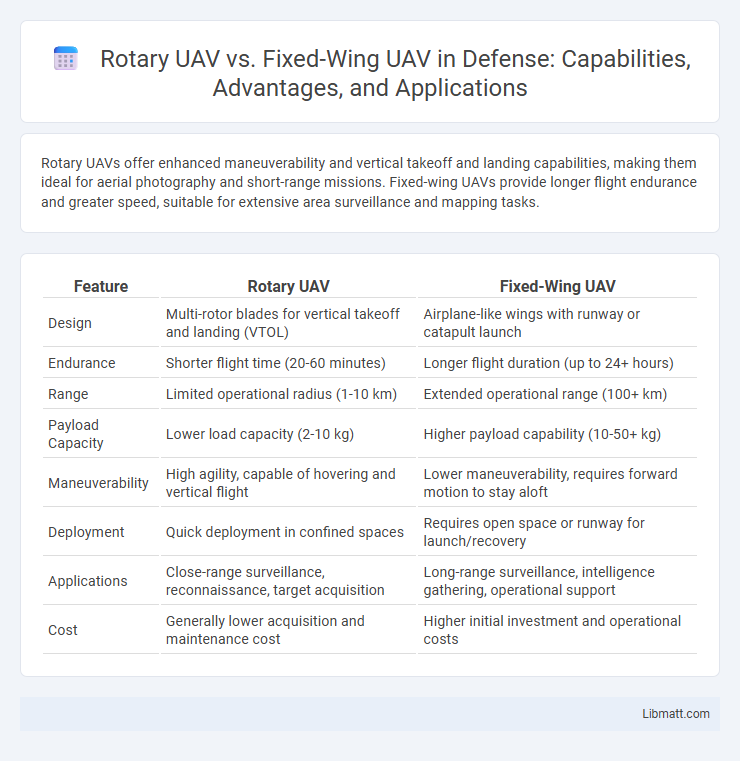Rotary UAVs offer enhanced maneuverability and vertical takeoff and landing capabilities, making them ideal for aerial photography and short-range missions. Fixed-wing UAVs provide longer flight endurance and greater speed, suitable for extensive area surveillance and mapping tasks.
Table of Comparison
| Feature | Rotary UAV | Fixed-Wing UAV |
|---|---|---|
| Design | Multi-rotor blades for vertical takeoff and landing (VTOL) | Airplane-like wings with runway or catapult launch |
| Endurance | Shorter flight time (20-60 minutes) | Longer flight duration (up to 24+ hours) |
| Range | Limited operational radius (1-10 km) | Extended operational range (100+ km) |
| Payload Capacity | Lower load capacity (2-10 kg) | Higher payload capability (10-50+ kg) |
| Maneuverability | High agility, capable of hovering and vertical flight | Lower maneuverability, requires forward motion to stay aloft |
| Deployment | Quick deployment in confined spaces | Requires open space or runway for launch/recovery |
| Applications | Close-range surveillance, reconnaissance, target acquisition | Long-range surveillance, intelligence gathering, operational support |
| Cost | Generally lower acquisition and maintenance cost | Higher initial investment and operational costs |
Overview of Rotary UAVs and Fixed-Wing UAVs
Rotary UAVs, equipped with multiple rotors, offer vertical takeoff and landing capabilities, hovering, and precise maneuverability, making them ideal for aerial photography, inspection, and short-range missions. Fixed-wing UAVs feature airplane-like wings that enable longer flight durations, higher speeds, and greater energy efficiency, suitable for extensive mapping, surveillance, and agricultural applications. The choice between rotary and fixed-wing UAVs depends on mission requirements such as flight time, payload capacity, and operational environment.
Design Differences: Rotary vs Fixed-Wing UAVs
Rotary UAVs feature multiple rotors allowing vertical takeoff, landing, and hovering capabilities, while fixed-wing UAVs utilize aerodynamic wings for efficient forward flight and longer endurance. The rotors provide superior agility and stability in confined spaces, whereas fixed-wing designs enable faster speeds and greater range due to lower energy consumption during sustained flight. Understanding these design differences helps you choose the right UAV based on mission requirements such as maneuverability versus flight duration.
Flight Capabilities and Maneuverability
Rotary UAVs, equipped with multiple rotors, excel in vertical takeoff, landing, and hovering, enabling precise maneuverability in confined or complex environments. Fixed-wing UAVs offer superior flight endurance and higher speeds due to aerodynamic lift but require runways or catapult launches and lack hovering capabilities. The choice between rotary and fixed-wing UAVs depends on mission-specific needs for agility versus range and endurance.
Payload Capacity Comparison
Rotary UAVs typically offer greater payload capacity flexibility due to their ability to hover and carry heavier equipment for tasks like aerial photography and inspections. Fixed-wing UAVs excel in endurance and range but generally have lower payload limits, optimized for lightweight sensors or cameras during long-distance surveys. Choosing between the two depends on your mission's specific payload requirements and operational environment.
Endurance and Flight Time
Rotary UAVs typically offer shorter endurance and flight times, ranging between 20 to 60 minutes, due to higher energy consumption from constant rotor activity. Fixed-wing UAVs excel in extended flight durations, often exceeding several hours, by utilizing more efficient aerodynamic lift from wings during forward motion. Your choice depends on mission needs, with rotary models suited for short, precise tasks and fixed-wing options preferred for long-range surveillance or mapping.
Launch and Landing Requirements
Rotary UAVs require minimal space for both launch and landing, often taking off and landing vertically without a runway, making them ideal for confined or rugged environments. Fixed-wing UAVs necessitate a runway or catapult system for launch and a clear area for landing, which limits their operational flexibility in tight spaces. The VTOL capability of rotary UAVs enhances their deployment speed and repeatability, especially in urban or densely forested areas.
Application Suitability: Industry Use Cases
Rotary UAVs excel in urban inspections, agriculture monitoring, and search-and-rescue operations due to their vertical takeoff and landing (VTOL) capabilities and superior maneuverability. Fixed-wing UAVs are ideal for long-range mapping, environmental monitoring, and large-scale agricultural surveys, offering extended flight endurance and higher speeds. Industries such as infrastructure inspection and precision farming benefit from rotary UAVs for detailed, localized tasks, while fixed-wing UAVs support applications demanding wide-area coverage and time-efficient data collection.
Cost and Maintenance Considerations
Rotary UAVs generally incur higher maintenance costs due to their complex mechanical systems with multiple moving parts such as rotors and gearboxes, which require frequent inspections and replacements. Fixed-wing UAVs benefit from simpler designs and fewer moving components, leading to lower long-term maintenance expenses and extended operational lifespans. Your choice between rotary and fixed-wing UAVs should weigh initial costs against ongoing maintenance, especially for applications demanding frequent or prolonged flights.
Environmental and Operational Limitations
Rotary UAVs face environmental limitations such as reduced flight time due to higher energy consumption and vulnerability to strong winds and turbulence affecting their stability and control. Fixed-wing UAVs offer longer endurance and better efficiency in covering large areas but require open landing spaces and are less capable of hovering or vertical takeoff in confined environments. Your mission parameters and operating conditions will determine whether the rotary UAV's maneuverability or the fixed-wing UAV's range provides optimal operational performance.
Choosing the Right UAV for Your Mission
Rotary UAVs offer superior maneuverability and hovering capabilities, making them ideal for detailed inspections, search and rescue, and close-range surveillance. Fixed-wing UAVs provide longer flight endurance and faster coverage, suited for mapping large areas, agricultural monitoring, and delivery tasks. Selecting the right UAV for your mission depends on balancing flight duration, area coverage, and operational flexibility to meet your specific needs.
rotary UAV vs fixed-wing UAV Infographic

 libmatt.com
libmatt.com